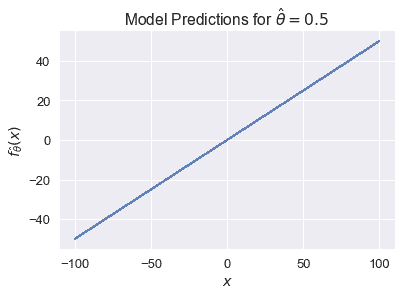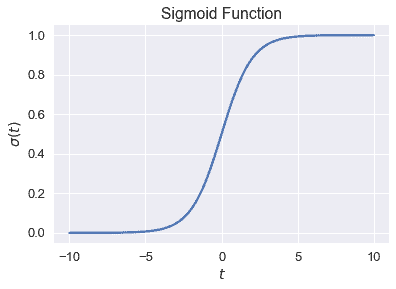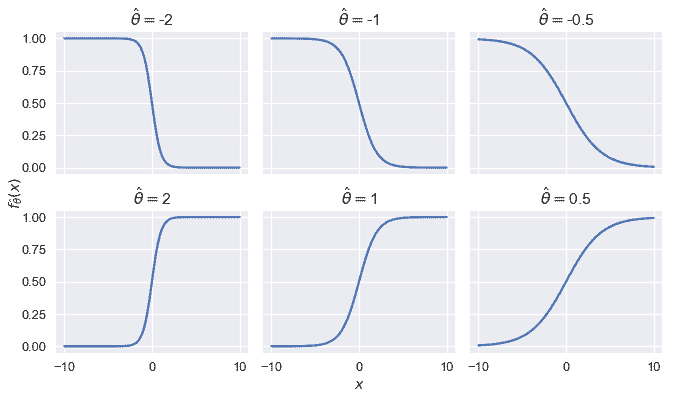# Logistic 模型
> 原文:[https://www.bookbookmark.ds100.org/ch/17/classification_log_model.html](https://www.bookbookmark.ds100.org/ch/17/classification_log_model.html)
```
# HIDDEN
# Clear previously defined variables
%reset -f
# Set directory for data loading to work properly
import os
os.chdir(os.path.expanduser('~/notebooks/17'))
```
```
# HIDDEN
import warnings
# Ignore numpy dtype warnings. These warnings are caused by an interaction
# between numpy and Cython and can be safely ignored.
# Reference: https://stackoverflow.com/a/40846742
warnings.filterwarnings("ignore", message="numpy.dtype size changed")
warnings.filterwarnings("ignore", message="numpy.ufunc size changed")
import numpy as np
import matplotlib.pyplot as plt
import pandas as pd
import seaborn as sns
%matplotlib inline
import ipywidgets as widgets
from ipywidgets import interact, interactive, fixed, interact_manual
import nbinteract as nbi
sns.set()
sns.set_context('talk')
np.set_printoptions(threshold=20, precision=2, suppress=True)
pd.options.display.max_rows = 7
pd.options.display.max_columns = 8
pd.set_option('precision', 2)
# This option stops scientific notation for pandas
# pd.set_option('display.float_format', '{:.2f}'.format)
```
```
# HIDDEN
def df_interact(df, nrows=7, ncols=7):
'''
Outputs sliders that show rows and columns of df
'''
def peek(row=0, col=0):
return df.iloc[row:row + nrows, col:col + ncols]
if len(df.columns) <= ncols:
interact(peek, row=(0, len(df) - nrows, nrows), col=fixed(0))
else:
interact(peek,
row=(0, len(df) - nrows, nrows),
col=(0, len(df.columns) - ncols))
print('({} rows, {} columns) total'.format(df.shape[0], df.shape[1]))
```
```
# HIDDEN
def jitter_df(df, x_col, y_col):
x_jittered = df[x_col] + np.random.normal(scale=0, size=len(df))
y_jittered = df[y_col] + np.random.normal(scale=0.05, size=len(df))
return df.assign(**{x_col: x_jittered, y_col: y_jittered})
```
```
# HIDDEN
lebron = pd.read_csv('lebron.csv')
```
在本节中,我们将介绍**逻辑模型**,这是一个用于预测概率的回归模型。
回想一下,拟合一个模型需要三个部分:一个预测模型、一个损失函数和一个优化方法。对于目前熟悉的最小二乘线性回归,我们选择模型:
$$ \begin{aligned} f_\hat{\boldsymbol{\theta}} (\textbf{x}) &= \hat{\boldsymbol{\theta}} \cdot \textbf{x} \end{aligned} $$
损失函数:
$$ \begin{aligned} L(\boldsymbol{\theta}, \textbf{X}, \textbf{y}) &= \frac{1}{n} \sum_{i}(y_i - f_\boldsymbol{\theta} (\textbf{X}_i))^2\\ \end{aligned} $$
我们使用梯度下降作为优化方法。在上面的定义中,$\textbf x$表示$n \乘以 p$的数据矩阵($n$表示数据点的数目,$p$表示属性的数目),$\textbf x$表示一行$\textbf x,$textbf y$表示观察结果的向量。矢量$\BoldSymbol \Hat \Theta 包含最佳模型权重,而$\BoldSymbol \Theta 包含优化期间生成的中间权重值。
## 实数与概率
观察到模型$f_ \hat \\\123\123\123; \123\\123\123\125\\\\125\\123\\\123\\\\\\\\\\\\\\\\.
当$x$是一个标量时,我们可以很容易地看到这一点。如果$\hat\theta=0.5$,我们的模型将变为$f \theta(\textbf x)=0.5 x$。它的预测值可以是从负无穷大到正无穷大的任意值:
```
# HIDDEN
xs = np.linspace(-100, 100, 100)
ys = 0.5 * xs
plt.plot(xs, ys)
plt.xlabel('$x$')
plt.ylabel(r'$f_\hat{\theta}(x)$')
plt.title(r'Model Predictions for $ \hat{\theta} = 0.5 $');
```

对于分类任务,我们希望限制$f_ \hat \boldSymbol \theta(\textbf x)$以便将其输出解释为概率。这意味着它只能输出$[0,1]$范围内的值。此外,我们希望$f_ux \boldsymbol \theta(\textbf x)$的大值对应于高概率,小值对应于低概率。
## Logistic 功能[¶](#The-Logistic-Function)
为了实现这一点,我们引入了**逻辑函数**,通常称为**乙状结肠函数**:
$$ \begin{aligned} \sigma(t) = \frac{1}{1 + e^{-t}} \end{aligned} $$
为了便于阅读,我们经常将$E^X$替换为$\text exp(x)$并写下:
$$ \begin{aligned} \sigma (t) = \frac{1}{1 + \text{exp}(-t)} \end{aligned} $$
我们为下面的值$t\in[-10,10]$绘制 sigmoid 函数。
```
# HIDDEN
from scipy.special import expit
xs = np.linspace(-10, 10, 100)
ys = expit(xs)
plt.plot(xs, ys)
plt.title(r'Sigmoid Function')
plt.xlabel('$ t $')
plt.ylabel(r'$ \sigma(t) $');
```

观察 sigmoid 函数$\sigma(t)$接受任何实数$\mathbb r,只输出 0 到 1 之间的数字。函数在其输入$t$上单调递增;根据需要,$t$的大值对应于接近 1 的值。这不是巧合,虽然我们省略了简单性的推导,但 sigmoid 函数可以从概率的对数比中推导出来。
## Logistic 模型定义
我们现在可以将我们的线性模型$\hat \boldSymbol \theta \cdot\textbf x$作为 sigmoid 函数的输入来创建**逻辑模型**:
$$ \begin{aligned} f_\hat{\boldsymbol{\theta}} (\textbf{x}) = \sigma(\hat{\boldsymbol{\theta}} \cdot \textbf{x}) \end{aligned} $$
换句话说,我们将线性回归的输出取为$\mathbb r 美元中的任意数字,并使用 sigmoid 函数将模型的最终输出限制为介于 0 和 1 之间的有效概率。
为了对 Logistic 模型的行为产生一些直观的认识,我们将$x$限制为一个标量,并将 Logistic 模型的输出绘制为几个值,即$hat \theta。
```
# HIDDEN
def flatten(li): return [item for sub in li for item in sub]
thetas = [-2, -1, -0.5, 2, 1, 0.5]
xs = np.linspace(-10, 10, 100)
fig, axes = plt.subplots(2, 3, sharex=True, sharey=True, figsize=(10, 6))
for ax, theta in zip(flatten(axes), thetas):
ys = expit(theta * xs)
ax.plot(xs, ys)
ax.set_title(r'$ \hat{\theta} = $' + str(theta))
# add a big axes, hide frame
fig.add_subplot(111, frameon=False)
# hide tick and tick label of the big axes
plt.tick_params(labelcolor='none', top='off', bottom='off',
left='off', right='off')
plt.grid(False)
plt.xlabel('$x$')
plt.ylabel(r'$ f_\hat{\theta}(x) $')
plt.tight_layout()
```

我们看到,改变\θ的幅度会改变曲线的锐度;距离 0$越远,曲线的锐度就越高。翻转$\hat \theta 的符号,同时保持大小不变,相当于反映 Y 轴上的曲线。
## 摘要[¶](#Summary)
我们引入了逻辑模型,这是一个输出概率的新预测函数。为了建立模型,我们使用线性回归的输出作为非线性逻辑函数的输入。
- 一、数据科学的生命周期
- 二、数据生成
- 三、处理表格数据
- 四、数据清理
- 五、探索性数据分析
- 六、数据可视化
- Web 技术
- 超文本传输协议
- 处理文本
- python 字符串方法
- 正则表达式
- regex 和 python
- 关系数据库和 SQL
- 关系模型
- SQL
- SQL 连接
- 建模与估计
- 模型
- 损失函数
- 绝对损失和 Huber 损失
- 梯度下降与数值优化
- 使用程序最小化损失
- 梯度下降
- 凸性
- 随机梯度下降法
- 概率与泛化
- 随机变量
- 期望和方差
- 风险
- 线性模型
- 预测小费金额
- 用梯度下降拟合线性模型
- 多元线性回归
- 最小二乘-几何透视
- 线性回归案例研究
- 特征工程
- 沃尔玛数据集
- 预测冰淇淋评级
- 偏方差权衡
- 风险和损失最小化
- 模型偏差和方差
- 交叉验证
- 正规化
- 正则化直觉
- L2 正则化:岭回归
- L1 正则化:LASSO 回归
- 分类
- 概率回归
- Logistic 模型
- Logistic 模型的损失函数
- 使用逻辑回归
- 经验概率分布的近似
- 拟合 Logistic 模型
- 评估 Logistic 模型
- 多类分类
- 统计推断
- 假设检验和置信区间
- 置换检验
- 线性回归的自举(真系数的推断)
- 学生化自举
- P-HACKING
- 向量空间回顾
- 参考表
- Pandas
- Seaborn
- Matplotlib
- Scikit Learn
